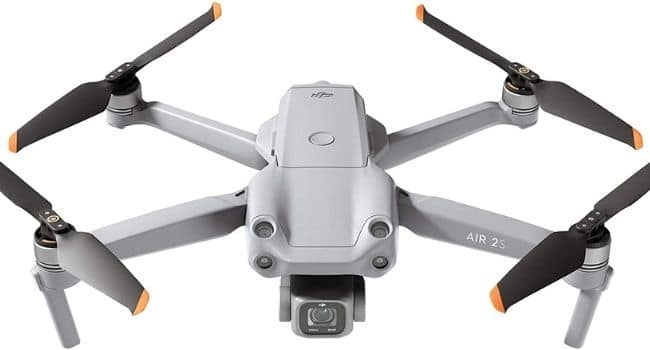The DJI Air 2S is an amazing drone that is perfect for professional photographers. It boasts an impressive 1-inch sensor camera that can take stunning 20MP still photos and record 5.4K videos at 30fps. With advanced photography modes like Smartphoto and the ability to record HDR videos in 10-bit D-log colour format, you can easily capture breathtaking photos and footage. The drone also features an obstacle avoidance system, autonomous flight modes, and 31 minutes of flight time, making it an excellent choice for aerial photography sessions. Additionally, ASPAS 4.0 technology ensures smooth and stable flying, enabling you to take clear and sharp shots even when the drone is in motion.
Key Features
- 1-inch CMOS sensor with 22mm lens and 88° FOV
- Fixed f/2.8 aperture
- 20MP images
- 8× Zoom
- SmartPhoto Mode for AI-powered HDR images
- Records videos in 5.4k at 30fps, 4k at 60fps, 2.7k at 60fps
- 10-bit D-log for HDR videos
- Intelligent flight modes
- 31 minutes of flight time
- 12km transmission range
DJI’s Air 2S has been one of the most popular consumer drones since it was released and it’s easy to see why. This is a mid-tier drone but comes with many of the innovative features that are usually only available on DJI’s high-end drone range. The DIJI Air 2S is the successor to the Mavic Air 2 and while the name suggests that there is little difference between the drones, there are actually some major upgrades, the most important being the large 1-inch sensor that comes with the DJI Air 2S. In this review, we shall go over the main features of this drone and how it stacks up against its competition.
DJI Air 2S Review
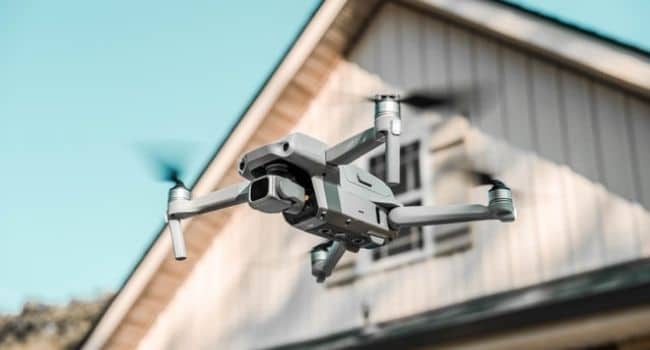
The DJI Air 2S is part of the Mavic range of drones, although, like the Mini 2, DJI has for some branding reason shed the Mavic name.
The overall design of the drone isn’t too dissimilar to its predecessor, although there are some notable differences.
The drone’s diagonal measurement is 302mm, this is the same as the Mavic Air 2, although it is slightly heavier at 595g, this is mainly because of its camera and extra sensors.
Still, this is a very lightweight drone and along with its compact foldable design, it is easy to carry around, this makes it great for those who travel a lot and are looking for a good drone for photography.
Like most other drones, it has LED lights on the end of each rotor, these indicate the different flight status of the drone and also help with identifying any issues with the drone. There is also an LED light on the belly that will help with navigating and landing the drone in twilight hours.
Like most new DJI consumer drones, the Air 2S comes with 8GB of internal memory, there is a micro SD card slot on the side of the drone that takes a maximum capacity of 256GB.
DJI Air 2S Review – Controller
The Air 2S uses the DJI RC-N1 controller, it’s the same controller as the Air 2 and Mini 2, although it uses DJI’s newer transmission system, 03, which provides the drone with a range of 12km.
The controller is big and is very different to the foldable ones that come with earlier Mavic models, which many people prefer, although, I personally don’t have any issue with it.
There is a telescopic arm that pulls out from the top that will allow you to attach a large smartphone and it has the usual necessary buttons for take-off/landing, automatic return to home, flight mode switch, recording videos, capturing images and a dial to control the gimbal.
For FPV and to access the drone’s more advanced features, you will need to download the DJI Fly App.
The Air 2S is also compatible with DJI’s smart controller which comes with the added benefit of a 5.5-inch high luminance LCD screen. It runs on the Android operating system and allows you to download third-party apps for extra functionality like live streaming on Facebook or YouTube.
DJI Air 2S Review – Camera
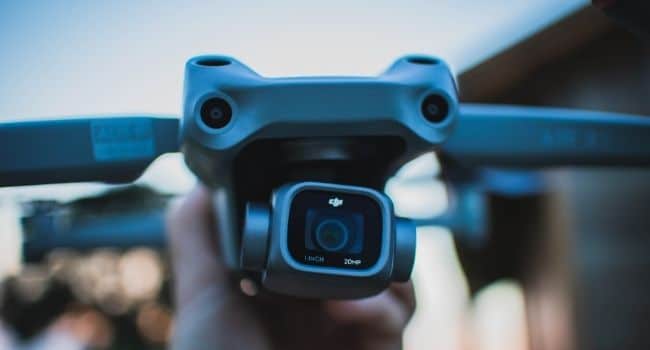
The main feature of this drone is its camera, and it has seen a major update from its predecessor.
The Air 2S comes equipped with a 1-inch CMOS sensor that has a focal length of 22mm, a fixed f/2.8 aperture and an 88° FOV.
The sensor is much larger than the one that comes on the Air 2 and is the same size as the sensor on the Mavic 2 Pro.
Larger image sensors result in more details being captured and better overall image and video quality. One thing to keep in mind this is the first drone with a 1-inch sensor that costs less than $1000, this is kind of a big deal when previous drones with a similar sensor size were priced well above $1500.
The camera is stabilised by a 3-axis gimbal that has a controllable tilt range of -90° – 24°, although the pan axis is unfortunately not controllable.
With its 20MP sensor, the camera can capture images in both JPEG and RAW and it comes with multiple photography modes such as burst, AEB, panorama and a SmartPhoto mode that will allow you to capture optimised images in HDR without the need for post-processing.
Videos can be recorded at a variety of resolutions and frame rates, the highest is 5.4k at 30fps, even the more expensive Mavic 2 Pro does not record at this resolution.
The camera can also record in 4k at 60fps, 2.7k at 60fps and FHD at 120fps and has a maximum video bitrate of 150Mbps.
Videos can be recorded in 10-bit D-log which will allow for more flexibility for colour correction in post-production. This is like the video recording mode on the Mavic 2 Pro and a huge upgrade to the Mavic Air 2.
The camera also has a high ISO range that will allow you to capture more details in low-light areas and reduce image noise for a clearer photo.
There is also a zoom function that allows you to zoom up to a maximum of 8×, although this is a digital zoom feature and so the quality will get grainy the more you zoom in. It’s still a decent feature, especially if you want to get a closer look at something without having to move the drone.
The drone has an internal memory capacity of 8GB, this is a new addition to the latest DJI drones, however, it’s not nearly enough memory, especially for those of you who will be recording videos in HD.
There is an external memory compartment that can take a micro SD with a maximum capacity of 256GB and has a UHS-I speed grade 3 rating.
Flight Features
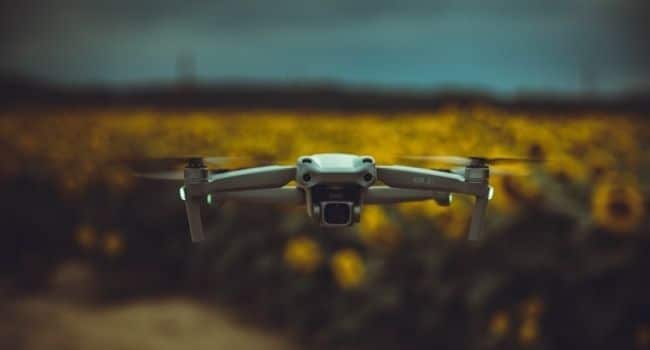
The Air 2S comes with the 3 flight modes, normal, sports and cine, this is the same as most other Mavic models, although cine may go under tripod mode.
Normal and cine modes are similar to each other, most of the drone’s features are available in these modes and they are the easiest to operate.
In sports mode, the controls are a little more sensitive and the drone can reach its top speed of 68 km/h.
There is an altitude hole mode that is activated whenever the GNSS signal is weak, and the obstacle avoidance sensors are disabled. This is the hardest mode to control as none of the flight stabilisation features are available, it’s good to practice with to improve your flight skills but it should be done in a wide-open area.
The drone is powered by an intelligent battery that provides it with a flight time of 31 minutes, although, this is if it is flown under perfect conditions, most people will achieve something around 28 minutes, which is still very good.
Its flight time is on par with the Mavic 2 Pro but slightly less than the Mavic Air 2, this is probably because the Air 2 weighs less and is powered by a similar type of battery.
Intelligent Features
The Air 2S comes with a host of intelligent features that makes it easier to fly and capture photos and videos.
The drone comes with several autonomous flight modes, these include Spotlight, ActiveTrack and Point of Interest (POI). Al these flight modes come under the FocusTrack menu on the DJI Fly App.
These modes allow you to focus the camera on a subject matter and depending on the tracking mode you choose, the drone will either follow the person/object (ActiveTrack), circle the POI or in the case of the spotlight mode the camera will be fixed on the subject matter while you manually operate the drone.
The drone has a new feature called Mastershots, this like an evolution of the Quickshot feature which comes with the Mavic 2, Air 2, Mini 2 and Mavic Mini.
With Mastershots, you will be able to create short cinematic videos while the drone automatically carries out 10 different manoeuvres.
Quickshots is a similar feature to Mastershots, however, instead of carrying out different manoeuvres, the drone does one manoeuvre out of a total of 6 you can choose from.
Both are fun ways to create cool short videos that can be easily edited and shared on social media.
You can also create time-lapse videos via the Hyperlaspe feature, there are 4 flight modes under this feature, in each mode, you will be able to adjust the time duration between each photo, video length and the maximum speed.
Finally, the drone comes with an intelligent return to home feature, this is activated manually via the button on the controller or via the DJI Fly app. The feature is also triggered automatically if the drone loses connection, or the battery gets low on charge.
Obstacle Avoidance System
The Air 2S comes with an upgraded obstacle avoidance system, it has 4-ways of obstacle sensing, which is an improvement to the Air 2’s 3-way sense and avoidance system but inferior to the Mavic 2 Pro’s omnidirectional system.
While the obstacle avoidance system is good, it is not as effective in areas where there are lots of obstacles close by, for instance, in a forest, an area where there are a lot of trees around. The drone that sets the standard in this area is still the Skydio 2, for which DJI still hasn’t found an answer, although the Mavic 3 is close.
Is The DJI Air 2S Worth It?
Whether or not the DJI Air 2S is worth it depends on your specific needs and use case.
The DJI Air 2S is a high-quality drone with many advanced features, including a 1-inch sensor camera capable of shooting 20-megapixel still photos and a 5.4K video at 30 frames per second. It also has a maximum flight time of up to 31 minutes and a video transmission range of 12km
If you are a photographer or videographer or someone who wants to capture high-quality aerial footage, then the DJI Air 2S is a great option. However, other more affordable options are available if you are just looking for a drone to fly for fun.
In the end, it’s up to you to decide whether the DJI Air 2S is worth the investment based on your specific needs and budget.
DJI Air 2S Alternatives
The main alternatives to the Air 2S are the drones I have mentioned throughout this review, they are the Air 2 and Mavic Pro 2. The table below highlights their main features and how they differ.
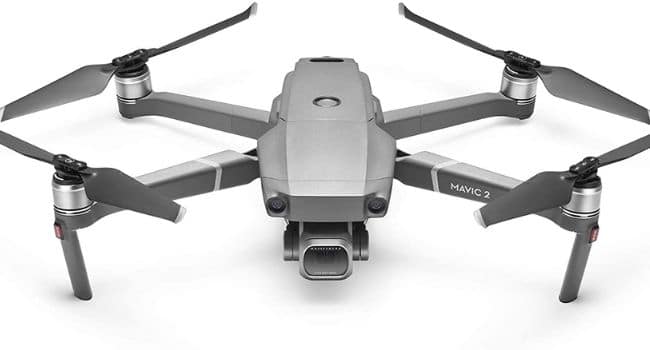
- 1-inch Hasselblad sensor with 28mm lens & 77° FOV
- Adjustable f/2.8-f/11 aperture
- 20MP images
- Burst,AEB,Interval Photography Modes
- 4k at 30fps & 2.7k at 60fps video footage
- 10-bit D-log colour profile for HDR videos
- 100Mbps
- 31 minutes of flight time
- 10km transmission range
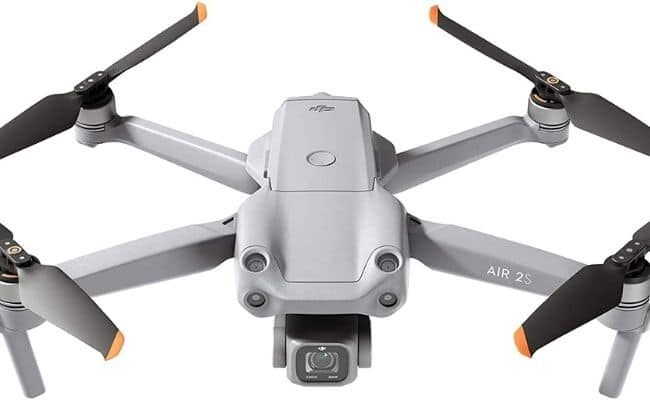
- 1-inch sensor with 22mm lens & 88° FOV
- Fixed f/2.8 aperture
- 20MP images
- Burst,AEB,Timed,SmartPhoto & HDR Panorama Photography Modes
- 5.4k at 30fps, 4k at 60fps & 2.7k at 60fps video footage
- 10-bit D-log HDR videos
- 150Mbps
- 31 minutes of flight time
- 12km transmission range
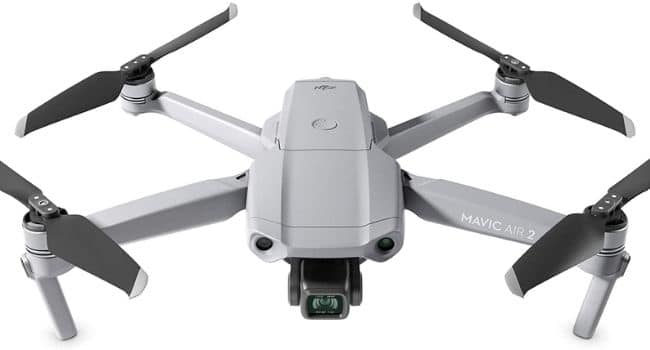
- 1/2-inch sensor with 24mm lens & 84° FOV
- Fixed f/2.8 aperture
- 12MP & 48MP images
- Burst,AEB,Timed,SmartPhoto & HDR Panorama Photography Modes
- 4k at 60fps & 2.7k at 60fps video footage
- D-Cinelike colour profile (8-bit) for HDR videos
- 120Mbps
- 34 minutes of flight time
- 10km transmission range
Final Thoughts
The Air 2S is an excellent drone; its features make it suitable for professional photographers, but even people looking for a good high-quality drone for fun and to capture amazing photos and videos for personal use.
FAQs
Does The DJI Air 2S Have a Remote ID?
Yes, the DJI Air 2S has Remote ID functionality, enabling it to broadcast its location and identification information to nearby authorities. The FAA requires this feature in the United States and the EASA in Europe.
How Far Can The DJI Air 2S Fly?
The DJI Air 2S has a maximum flight range of up to 18km when flying in ideal conditions and a maximum image transmission range of 12km with no obstructions or signal interference. However, it’s important to note that drone pilots should always follow local regulations and maintain visual line-of-sight with their drones, as well as consider factors such as battery life and weather conditions when planning their flights.
How High Can The DJI Air 2S Fly?
The DJI Air 2S has a maximum altitude limit of 5000 feet above sea level. However, the limit set by the FAA and by regulatory agencies in many countries is 400 feet. This is designed to ensure safe and responsible drone operation. It’s essential for drone pilots always to follow local regulations and avoid flying their drones above the maximum allowable altitude.
Does The DJI Air 2S Have Follow Me?
Yes, the DJI Air 2S has a “Follow Me” feature called ActiveTrack by DJI. This feature uses advanced computer vision technology to track and follow a subject while keeping it in the centre of the frame, allowing for hands-free operation while capturing dynamic footage. ActiveTrack on the DJI Air 2S can track a subject from the front, behind, or side and can avoid obstacles while in operation.

